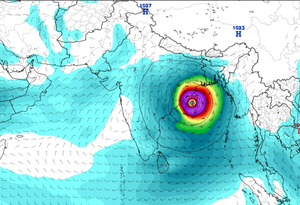Over 1.38 Lakh Winter, Migratory Birds Throng Bhitarkanika Park: Survey

Kendrapara, Jan 14: An estimated 1,38,107 winter birds belonging to 144 species thronged to Bhitarkanika National Park in the ongoing winter season, as per the report of mid-winter waterfall bird status survey -2022.
The bird status survey -2022 was carried out in five forests and wildlife ranges under Bhitarkanika National Park on January 12 under the guidance of ornithologists, Doctor Jangyadatta Pati, DFO of Rajnagar Mangroves (forest) and wildlife Division said.
He said this year, 23 more bird species and 2015 more winter feathered guests have been spotted in the water bodies of the National park during the annual migratory bird status survey.
During last year survey, as many as 121 types of bird species with a population of 1,36,092 spotted in Bhitarkanika National park carried out on January 6, 2021.
The DFO said 17 survey teams were engaged in the bird status survey this year.
An estimated 34,009 brown-headed gull came to Bhitarkanika National park, which is reportedly the highest number bird population, visited this winter to National park.
This year, Geese and Ducks arrived more than other bird species. An estimated 59,286 population of 16 types of Geese and ducks were spotted during the status survey followed by 34,353 Gulls belonging to seven species.
An estimated 16,821 sore birds-waders of 30 types and 7879 herons, egret and bitterns population of 10 types too visited this winter to the Bhitarkanika National park.
However no Pelicans, Cranes or Flamingos, Indian Skimmer species were spotted at like last year, the DFO said.
While one type of grebes with a population of 329, four types of cormorants with a population of 4835, along with 3 types of storks with a population of 5059, 3 types of Ibises and spoonbill with a population of 3151 and two types of fin foot with a population of 590 along with 61 types of additional species of water birds with a population of 5127 visits to the park area this time.
As many as 168 Indian shag and also Oriental darter with a population of 399 were spotted during the census.
Similarly, one of the bittern species with a meagre population of 23 and five types of heron species, including 56 black-crowned night heron, 1280 Indian pond heron, 2 striated heron, 94 purple heron and 497 Grey heron were spotted during the enumeration drive of avian guests.
Four varieties of Egrets, including 2610 cattle Egret, 1967 Little Egret, 824 Intermediate Egret, 523 Great Egret and Little Egret were spotted by the enumerators.
As many as 733 painted stork, 4324 Asian Openbill and 38 lesser Adjutant were also sighted during the mid-winter waterfall bird status survey.
Spot-billed ducks, which is enlisted in the IUCN Red Data book, were once again sighted. Only two spot-billed ducks were spotted this time, the DFO said.
Some of the winter migratory bird species like Black-winged stilt, black-tailed Godwit, Mongolian plover, White-tailed plover, Rudey shell duck, Northern pintail, Avocet, Whimbrel, Spotted Redshank, ruff, generally comes from the cool places were sighted by the forest department during the status survey.
Bird species like Western Reef Egret, Goliath Heron, Oriental Pratincole, ibis bill, Mongolian plover, Dunlin, Broad-billed sandpiper,caspain tern, Indian skimmer, Great bittern, western Reef Egret, Goliath Heron, greater adjutant, Eurasian (white)spoonbill, Siberian crane-like species were not spotted during the survey, official sources said.
Migratory birds fly thousands of miles to Bhitarakanika to escape the harsh winter in Siberia, Afghanistan, Iraq, northern Asia and some central European countries.
The Bhitarkanika is stated to be the transit point for these migratory bird species as they throng in large numbers when chill is increased. The migratory birds returned when the water bodies dried up.






